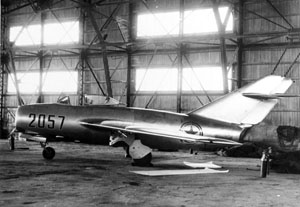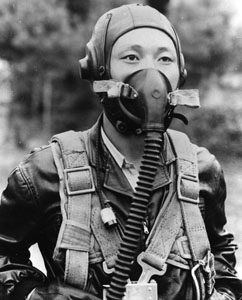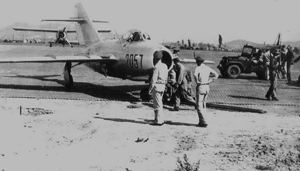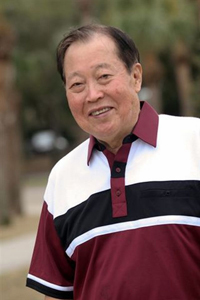It was midmorning, Sept. 21, 1953, and a few airmen were in the 4th Fighter-Interceptor Group’s intelligence film library reviewing gun camera film. Suddenly, someone began shouting, “A MiG just landed! A MiG just landed! Pandemonium broke out as people ran for the doors to get a look at the famed enemy aircraft and its pilot.
 | ||
|
US airmen at Kimpo AB, South Korea, hustled Lieutenant No’s MiG-15bis into a base hangar to protect it from prying eyes. (USAF photo) |
A gaggle of airmen raced down the perimeter road toward the south end of the runway at Kimpo AB, South Korea, where the 4th Fighter-Interceptor Wing’s air defense alert area was located.
And there it sat—nosed in amongst the 10 armed and ready F-86 Sabres.
North Korean Air Force Sr. Lt. No Kum-Sok had parked his silver MiG-15bis in an open spot on the Kimpo alert pad, vacated just minutes before by two Sabres from the 334th Fighter-Interceptor Squadron. They had been scrambled for a practice radar intercept mission.
Yet, until the moment he landed, the allied air defense network had been unaware of the MiG’s presence.
As he stopcocked the fighter’s jet engine, the 21-year-old North Korean pilot had set in motion the first stage of his boyhood dream: to become an American citizen.
This dream had been the primary reason for his volunteering first for the naval academy and then for training as a fighter pilot. He felt a ship or an airplane offered the best chance for escaping an unbearable life under Stalinist communism in North Korea.
Don’t Get Lost
His escape was a dangerous but calculated undertaking. Throughout the flight he was vulnerable to attack by his own comrades, American anti-aircraft guns, and the numerous USAF fighters he spotted swarming around Kimpo like bees from a hive. He was fortunate, too, that the entire Korean peninsula was graced with clear weather.
At his newly assigned home airfield in North Korea, Sunan Air Base, Lieutenant No was the first pilot scheduled to fly one of 16 recently delivered MiG-15s. The aircraft had been smuggled in by rail and hastily reassembled, in violation of the armistice agreement. Unlike aircraft for his wartime flights out of Antung AB, China, these late-model MiGs had not yet been fitted with external fuel tanks. This meant their range was quite limited. But having studied his map carefully in the preceding months, No knew the ship’s internal fuel supply was adequate for the flight to Kimpo.
The newly reactivated Sunan runway was still badly scarred from constant bombing during the war. Located about five miles northwest of Pyongyang, the air base placed him some 95 miles north of the 38th parallel, with Kimpo just 10 miles farther south. It was the closest he had been yet to the Demilitarized Zone.
The young lieutenant’s assigned mission that day was a proficiency flight—his first since arriving from China at war’s end. While walking across the ramp to his assigned fighter, he encountered Gen. Whal Lee, vice commander of the North Korean Air Force. Lee was one of the few senior officers in their Air Force with any significant education—even some university training—and he was well-respected. On seeing No, the general greeted him by name, then patted him on the shoulder and advised him to take care because of the craters and ruts on the runway.
“Oh, yes, and don’t get lost,” he added.
Because his was the first aircraft scheduled to depart, No reasoned he would also be expected to land first, which meant he’d be missed too quickly. Consequently, he asked the No. 2 pilot to exchange slots with him and depart first, telling him, “I’ll be up a little longer today. … Don’t land too soon, for as soon as you land, they’ll tell me to land.”
Then came some good luck. As if by providence, at about the time of his takeoff the US air defense radar just north of Kimpo was shut down temporarily for routine maintenance. With this unique stroke of luck, No was able to reach Kimpo unchallenged.

| ||
|
No in his North Korean flight suit. He managed to land the MiG safely at Kimpo while navigating landing and departing air traffic—downwind. (National Museum of the US Air Force photo) |
As he approached the American base he could see F-86s departing and landing to the north. Apparently, pilots in the traffic pattern didn’t recognize his swept-winged fighter as an enemy MiG-15, as their routine never changed. Still, to avoid being recognized by the base anti-aircraft unit, he chose to land downwind—into the landing and departing traffic. This had been routine procedure at Antung, where F-86s often attacked their landing aircraft.
Despite the hazardous head-on approach and landing, he pulled to a stop with a fully operational airplane.
His defection was a long time coming. No’s resistance to communism had begun at age 13, when he began voicing his contrary opinion in school. He had been influenced by his English studies and Voice of America broadcasts. His English teacher and sports coach had influenced him, too. Educated in a Japanese university, as an Army officer, he had fought against the Chinese communist Army. But it was No’s father who played the largest role in discouraging him from any pro-communist views.
At the Academy
Despite his youth, No began sensing danger for his rebellious outbursts and decided to keep his mouth shut. In July 1949, he was accepted into the North Korean naval academy. No recognized the need for a college level education—and the Navy could offer the chance of escape.
Discipline at the academy was severe. Cadets had no days or weekends off, no chance to leave the base, no vacations, and no visitors until graduation. Beards and mustaches were forbidden, and cadets were instructed to shave daily—but not provided razors. Their solution was to pull out the whiskers with their fingernails.
Classes in calculus, physics, chemistry, meteorology, navigation, communist history, gymnastics, calisthenics, even infantry training and marching for military parades, were held seven hours a day, seven days a week. The cadets were allowed only two hours each day for study and about four hours per night to sleep.
Living conditions were barbaric. During the harsh cold of winter, both the barracks and classrooms were poorly heated. As for water, there were only three faucets in each barracks and no hot water. “The food was insufficient, and everyone was always hungry,” No recalled. He described the academy as being “like a penitentiary, much more so in practice than appearance.”
One of Cadet No’s classmates submitted his resignation; it was flatly rejected—with a warning that he would be imprisoned if he submitted it again. Academy officials didn’t want anyone leaving and spreading stories about the extreme hardships the cadets were forced to endure.
Once the war started, their day-to-day life became even tougher. The 150 cadets in No’s class were moved 60 miles north and housed in a newly constructed railroad tunnel that had not yet been equipped with rails. The floor was muddy and the air dank. There he and his classmates lived, taking infantry training and enduring endless political meetings that denounced American aggression.
Then one day, a dozen doctors arrived at their tunnel and randomly selected 100 cadets for extensive physical exams. While the project’s mission was secret, No suspected it involved flight training. He recognized immediately the possibility of escaping by air to the south.

| ||
|
Airmen rushed to the MiG, shown here at Kimpo. (Photo via John Lowery) |
Although not among those initially selected for the physical, he noted that his Communist Party history instructor was recording student scores on spin tests being conducted in a swivel chair. Cadet No approached him and asked if he could take the test. The professor recognized him as having made an A in his history class three months earlier. After considering No’s request for a moment, the professor nodded affirmatively and said yes.
Out of the 100 cadets who took the spin test and subsequent physical, only 50 were selected—with No being the only volunteer for what was described as “a special, unnamed assignment.” Not until after they had been transported by train at night to a Chinese airfield did the base’s vice commander inform the group they were to be trained as fighter pilots.
Lieutenant No and his classmates completed their MiG-15 training in September 1951. Life as a North Korean fighter pilot was severe. He and his classmates were never given a furlough or overnight pass—or even a full day off the air base. They were not allowed to drink alcohol in public. Although the young pilots were all single, dating women was forbidden. They were warned that many young Korean girls were South Korean agents.
Combat Ready
The new graduates were assigned to the Second Air Regiment of the North Korean First Air Division. Meanwhile, the North Korean high command decided to deploy their new fighter regiment to Uiju Air Base, the only surviving airfield in North Korea.
The next day, Nov. 8, 1951, the newly minted 19-year-old fighter pilot flew his first combat mission. The procedure was to take off and immediately cross the border into the sanctuary of Chinese airspace; then recross into North Korea at an altitude higher than the early F-86As could reach. Fortunately, on his first few missions he encountered no F-86s. Only when he began to fly combat missions did he become aware of some of the MiG-15’s limitations.
Amazingly, this supposedly combat ready fighter pilot had never fired the aircraft’s guns. Upon firing them for the first time he was instantly alarmed by the heavy vibration from the slow-firing 37 mm and 23 mm cannons. He noted, too, that at 1,000 feet, “the tracer rounds dropped.” Conversely he noted the Sabre had six fast-firing guns whose trajectory seemed to stay straight for up to 3,300 feet—nearly three times farther than the MiG cannon.
Fighter pilots were expected to shoot their guns on every mission; yet he had no concept of aerial gunnery—estimating distance and lead using the MiG’s archaic World War II-era gunsight. “Consequently,” he said, “like most MiG pilots, I never hit anything.”
Canopy frosting was another major problem. The aircraft would typically frost up in the rear quadrants, preventing the pilot from seeing an aircraft attacking from behind. The space between the double layers of Plexiglas was supposed to contain dry air, but due to poor maintenance this was not often the case. Adding to the problem was the lack of a rearview mirror—a simple item that would have allowed the pilot to see an aircraft attacking from the vulnerable rear quadrants.
Worse yet was the MiG-15’s T-tail configuration. With the horizontal stabilizer mounted halfway up the rudder, it not only blocked visibility to the rear, but posed a hazard to a pilot whose ejection seat failed to fire, thus forcing him to dive out.
The airplane’s limited fuel supply was a significant constraint. Without external wing pylon fuel tanks, it could remain airborne for about 40 minutes. The engine was limited to 10 minutes at full power “to avoid an engine fire,” but No reported that to maintain a high airspeed he and his fellow pilots typically flew at full throttle from takeoff to landing and never saw an engine fire. Still, in combat, even with the additional fuel provided by wing pylon tanks, their maximum flight time was usually limited to less than 35 minutes.

| ||
|
A reproduction of the check for $100,000 that No received for delivering an intact MiG from North Korea. No insisted that neither he nor any other North Korean pilots knew of the bounty offer. |
At Uiju, B-29 raids made life unbearable, leaving their runway with 20-foot bomb craters. This kept their aircraft grounded most of time. Mercifully, after yet another air raid, their commanders decided to abandon the airfield and move back to Antung.
There were three air divisions based at Antung: the Chinese Second Interceptor Division, the elite Russian 324th Fighter Air Division from the Moscow Air Defense District, and now the North Korean Air Division. Soon after landing, No learned the Russians were flying the more advanced MiG-15bis (“bis” is Russian for “revised”). Its VK-1 engine had 6,000 pounds of thrust and an improved rate of roll, thanks to hydraulically boosted ailerons.
In addition, the Russian aircraft had armor-plated seat backs to protect the pilot. A month after their arrival at Antung, anti-ballistic steel plates were installed in all the aircraft. Then, in November 1952, No’s squadron finally received the improved MiG-15bis.
The North Korean loss rate in accidents and combat was horrendous, but there was political attrition as well. One pilot in No’s outfit, with about 50 combat missions, was suddenly discharged in disgrace when the security officer learned his brother had gone with South Korean forces in 1950. Concurrently, the popular commander of the North Korean Eleventh Air Division, consisting of mostly Yak-18 and Il-10 propeller airplanes, was accused of planning to defect to the West and was executed by firing squad without a trial.
The political heat affected No, too. His uncle, You Ki-Un, a major in the supply corps and a dedicated communist, visited him in the spring of 1953. He told No that his mother had been killed in a bombing raid—but actually he knew she was safe in the south. When the Chinese Army had begun retaking North Korea, she was evacuated with a broken leg by the US Navy from Hungnam to South Korea.
But You apparently told the First Air Force commander that No’s mother was alive in South Korea. Compounding the problem was that during April, American leaflets had been distributed offering $100,000 to a defecting MiG pilot. These factors combined to trigger a security investigation of the young pilot. Fortunately, his battalion vice commander and the commander of First Air Division had each given high praise to No as both a fighter pilot and dedicated communist. No continued flying combat missions.
In 1952, the North Korean government decreed family members of any defector would be executed. Fortunately, No’s mother was safely settled in South Korea, and it was not until a 1970 visit to Seoul that he learned of the retribution resulting from his escape.
In discussing his case with a pilot who defected in 1955, No learned that several of his associates were executed. His best friend, who in fact did know of his plan, was the first to die. His execution was followed by those of the battalion commander, with whom he had spent his last day at Sunan; his vice battalion commander who had vouched for his loyalty during the earlier security investigation, along with the battalion’s political officer; the air division’s chief weapons officer who had sponsored No’s Communist Party membership; his regimental commander; and the commander of the North Korean First Air Division.
In addition, he suspects his uncle was executed, too.
MiG-15 Evaluation

| ||
|
No Kum-Sok became a US citizen and took the name Kenneth Rowe. He worked as an aeronautical engineer for Boeing, General Dynamics, and Lockheed, among other defense companies. (Photo by Steven Notaras, a1a photo, via John Lowery) |
No’s defection came at a high cost, but since he was the first to bring in an intact MiG-15, it had great value as well.
Three USAF test pilots evaluated the MiG: Maj. Gen. Albert Boyd, Maj. Charles E. Yeager, and Capt. H. E. Collins. They found contemporary Sabres superior to the MiG in every respect. While the MiG-15 had a better thrust-to-weight ratio that allowed it to climb higher than the early model Sabres, the F-86F could also reach 55,000 feet (albeit not without exceeding the engine’s exhaust gas temperature limit). Missions in the F model were routinely flown at 49,000 feet, with a cruise speed of 0.9 Mach.
Among the predominant flight-test findings were that the aircraft had a strong nose-up pitch at .83 Mach. Its official speed limitation was .92 Mach, at which point a red warning light illuminated.
In addition, the MiG was found incapable of going supersonic. In one test, Yeager made a vertical dive at full power, to establish once and for all the airplane’s maximum speed. The airplane never exceeded .98 Mach. At that speed, the shockwave caused severe flight control vibrations—the aircraft became unresponsive above .93 Mach. Testing found problems with unexpected pitching, unrecoverable spins, lack of any stall warning, a very poor pressurization system, and a particularly dangerous emergency fuel pump.
No subsequently immigrated to the United States and learned English. Then, from the University of Delaware, he earned degrees in mechanical and electrical engineering. He married an émigré from Kaesong, Korea. They raised two sons and a daughter. The sons graduated from college as engineers and the daughter as a lawyer. After working in several defense-related industries, he ultimately retired as professor of aeronautical engineering from Embry-Riddle Aeronautical University in Daytona Beach, Fla.
In retirement—and despite advancing age—Kenneth Rowe (his anglicized name) is a sought after speaker. His story and book, A MiG-15 to Freedom, are riveting accounts of life under the North Korean government.